Prehistoric Animals were Show Offs According to New Research
New Study suggests Prehistoric Animals “Dressed to Impress”
A new study into the ornamentation of prehistoric animals that has been preserved in the fossil record concludes that fancy crests, frills and sails on the back were evolutionary adaptations to attract a mate. An international team of scientists, led by Dr Joseph Tomkins of Hull University have studied several iconic creatures from the fossil record and concluded that many of the elaborate head crests, spines and sails that these animals had were primarily to attract mates. In essence dinosaurs and other prehistoric animals “dressed to impress”.
Prehistoric Animals
Animals in the study included the large pterosaur Pteranodon (Pteranodon longiceps) and the Permian pelycosaurs Dimetrodon and Edaphosaurus (Dimetrodon grandis and Edaphosaurus pogonias).
Earlier studies had concluded that these physical characteristics such as large head crests on pterosaurs or sails on the back of some pelycosaurs played a role in thermoregulation. However, this latest analysis has found that the size of the Pteranodon’s head crest for example, was to big to play a role in temperature control.
Previously, scientists thought these physical characteristics were associated with thermal regulation. However, the latest study found the size of the pterosaur’s head crest was too big to play a role in temperature control.
An Illustration of a Model Skeleton of Pteranodon (P. longiceps)

Picture credit: Everything Dinosaur
To view the wide range of dinosaur and prehistoric animal themed toys and gifts available from Everything Dinosaur’s award-winning website: Visit Everything Dinosaur.
In a statement, the palaeontologists discussed the sail-back reptiles such as Dimetrodon and Edaphosaurus, they statement said:
“Furthermore, small ancestral, sail-backed pelycosaurs would have been too small to need adaptations to thermoregulation.”
An Illustration of a Dimetrodon (D. grandis)
Everything Dinosaur stocks a variety of Dimetrodon models, including the Papo Dimetrodon model.
View: Papo Prehistoric Animal Models.
The researchers plotted the relationship between metabolism and body size for each of the extinct creatures they studied. They linked bigger crests and sails to the need to attract mates, with such features becoming more exaggerated over time. We are not sure whether any extant creatures with large crests or other forms of ornamentation were studied. Frilled lizards from Australia (Chlamydosaurus kingii) have a neck frill that is mainly used as a defence, but comparing the size of this frill and scaling it in the same way as the extant animals could provide an interesting and contrasting insight to this research.


